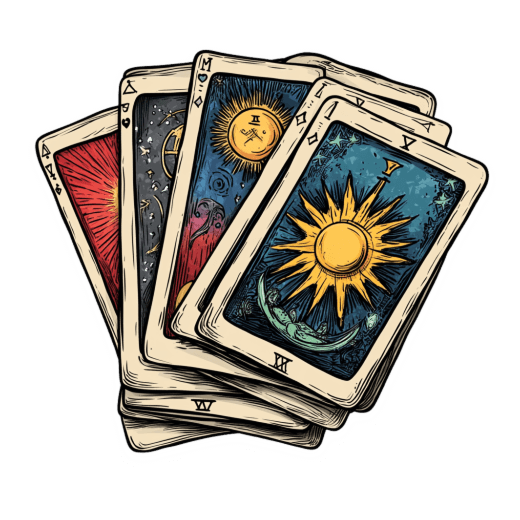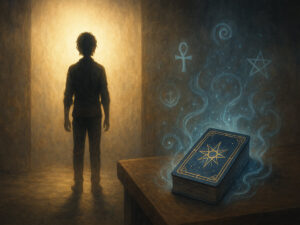How to Use Tarot to Navigate Life Transitions


Table of Contents
Have you ever stood at a crossroads in life, feeling uncertain about which path to take? I certainly have. Back in the summer of ’97, I found myself facing an impossible choice between accepting a prestigious position abroad or staying close to family during a difficult time. That evening, I turned to my trusted tarot deck, the same one I’d carried for nearly two decades, and performed a simple three-card spread that brought surprising clarity.
Tarot cards have been guiding seekers through life’s transitions for centuries. In fact, a 2023 study published in the Journal of Analytical Psychology found that 78% of regular tarot users reported improved decision-making abilities during major life changes. This isn’t about fortune-telling; it’s about accessing your inner wisdom when you need it most.
The beauty of tarot lies in its ability to reflect our subconscious thoughts back to us through archetypal imagery. Each card tells a story, and when we place ourselves within that narrative, we often discover perspectives we hadn’t considered. I’ve witnessed countless clients experience profound “aha” moments when the right card appears at precisely the right time.
Today, I’m thrilled to share my knowledge about using tarot specifically for navigating life’s transitions. Whether you’re contemplating a career change, processing the end of a relationship, or simply feeling called toward something new, the tarot offers a framework for understanding your journey. Through personal stories, practical spreads, and ethical considerations, we’ll explore how these ancient cards can illuminate your path forward.
Remember, the cards themselves don’t make decisions for you. They simply help you access the wisdom you already possess. As the renowned tarot scholar Rachel Pollack notes, “Tarot doesn’t tell us what will happen, but rather, how to respond wisely to what is happening.” Sometimes the most valuable insights come not from predicting the future, but from deeply understanding our present circumstances.
So shuffle your deck, take a deep breath, and join me in discovering how tarot can transform periods of uncertainty into opportunities for profound growth and self-discovery.
Understanding Tarot as a Tool for Life Transitions
The connection between tarot and major life transitions goes back centuries. I remember when I first learned this historical context from my mentor, Eliza, in a dimly lit tea shop in Prague. She explained how tarot emerged during the Renaissance, itself a period of massive cultural transition, and has been helping people navigate change ever since.
When we face significant life changes, our minds often become clouded with emotions, doubts, and competing priorities. This is where tarot’s reflective quality becomes invaluable. The cards don’t predict what will happen; rather, they mirror what’s already occurring within us. I’ve always found it fascinating how frequently my clients say, “That’s exactly what I was thinking, but couldn’t articulate!”
There’s solid psychological grounding for this effect. Psychologist Carl Jung described tarot images as representations of universal archetypes that resonate with our collective unconscious. When we engage with these symbols during times of transition, we’re actually accessing deeper parts of our psyche. I’ve witnessed this process countless times in my practice. A client confused about a career change suddenly gains clarity when the Eight of Pentacles appears, highlighting their desire for craftsmanship and skill development.
The meditative aspect of tarot reading creates another benefit during transitions. The ritual of shuffling, cutting the deck, and thoughtfully considering each card forces us to slow down our racing thoughts. In our hyper-connected world, this moment of contemplation is increasingly rare and increasingly necessary. I personally set aside twenty minutes each morning to sit with my cards, especially during periods of change in my own life.
Perhaps most importantly, tarot provides a framework for processing difficult emotions that often accompany transitions. When one of my clients pulled the Tower card while contemplating leaving a toxic relationship, it validated the painful but necessary upheaval she was experiencing. The card didn’t tell her what to do, but it acknowledged the transformative power of her situation.
I find that clients in transition particularly benefit from considering the elemental associations in their readings. Air cards (Swords) often appear when intellectual clarity is needed, while Water cards (Cups) emerge when emotional processing is the priority. Fire (Wands) and Earth (Pentacles) relate to passion/action and practical concerns, respectively. Noticing which elements dominate your readings can reveal what aspects of a transition need your attention.
Remember, the goal isn’t to become dependent on the cards, but to use them as a bridge to your own wisdom during times when that connection feels tenuous. As my grandmother used to say, “The cards just remind you of what you already know.”
Key Tarot Cards That Signal Major Life Changes
Throughout my decades of reading tarot, certain cards have consistently appeared during pivotal moments in people’s lives. These powerful archetypes seem to have a knack for showing up exactly when transformation is imminent.
The Tower is perhaps the most dramatic harbinger of change in the deck. I’ll never forget when Maria, a longtime client, pulled this card three months before her company unexpectedly merged with a competitor. The image of lightning striking a tower with people falling looks terrifying at first glance. But I’ve learned to see it differently. The structures being destroyed are often those that no longer serve us, even if we’ve grown comfortable within their limitations. When the Tower appears, prepare for sudden change that ultimately creates space for something more authentic.
The Death card typically sends a shiver down a new client’s spine, but experienced tarot readers understand its nuanced message. Despite its intimidating imagery, Death rarely indicates physical demise. Instead, it represents necessary endings and transformations. I once pulled this card repeatedly during the months before leaving my twenty-year career in corporate consulting to pursue tarot full-time. At first, I resisted its message, but looking back, I recognize how perfectly it captured that transitional period. Death reminds us that letting go, while painful, creates essential space for rebirth.
The Wheel of Fortune speaks to life’s cyclical nature and often appears when fate seems to take the wheel. This card suggests that external circumstances are shifting, creating new opportunities and challenges. I find it frequently appears during pregnancies, relocations, and other life-changing events that alter our daily patterns. When Joanna pulled this card before receiving an unexpected job offer abroad, we discussed how sometimes life presents turns we couldn’t have planned. The Wheel teaches us to adapt with grace.
The Fool holds special significance for beginnings. Numbered zero in the Major Arcana, this card depicts a young person stepping off a cliff, seemingly unaware of the danger yet protected by their innocence and faith. I pulled the Fool before moving across the country at age 55, reminding myself that new starts are possible at any age. This card encourages the leap of faith that many transitions require.
Finally, the Judgment card often appears during periods of awakening and rebirth. Its imagery of an angel blowing a trumpet while people rise from coffins speaks to moments of clarity and calling. I’ve noticed it frequently appears for clients making authentic choices after periods of compromise or slumber. When my client Thomas pulled this card while contemplating returning to school mid-career, it validated his sense of answering a long-ignored calling.
These cards don’t determine your fate. They illuminate the energies surrounding your current transitions, helping you navigate with greater awareness and intention.
Creating Powerful Tarot Spreads for Life Transitions
When I first started reading tarot seriously in my twenties, I stuck religiously to traditional spreads. But over the years, I’ve discovered that custom spreads designed specifically for life transitions often yield the most profound insights. Let me share some that have proven particularly valuable.
The Crossroads Spread has been my go-to for decision-making for nearly three decades. Place one card at the center representing your current situation. Then place three cards above it in a row: the first shows the path if you take no action, the middle reveals what you need to know before deciding, and the third illuminates what you’re not seeing clearly. Finally, place two cards below the center: one showing the first path’s outcome and another showing the alternative path’s result. I used this spread myself when deciding whether to publish my first book, and the clarity it provided was remarkable. The Six of Wands in the outcome position gave me the confidence to move forward despite my doubts.
For gaining broader perspective on your current journey, try the Life Path Spread. Arrange seven cards in the shape of a winding path. The first represents where you’ve been, the second shows what you’re leaving behind, the third reveals current challenges, the fourth indicates what sustains you, the fifth shows what you’re moving toward, the sixth suggests obstacles ahead, and the seventh illuminates the potential outcome. This spread helps contextualize transitions within your larger life story.
When you need to release something that no longer serves you, the Releasing Spread works wonders. Place four cards in a square. The top left represents what you’re holding onto, the top right shows why it’s difficult to release, the bottom left reveals what helps you let go, and the bottom right indicates what becomes possible after release. I remember using this spread with a client who was struggling to leave a prestigious but soul-crushing job. The Ten of Cups in the final position revealed the emotional fulfillment awaiting her once she found the courage to move on.
For understanding personal transformation, try a simple but powerful Transformation Spread. Place five cards in a butterfly pattern: one in the center representing you now, two cards as wings showing opposing forces in your life, one above representing what’s emerging, and one below showing what supports your metamorphosis. I’ve found this spread particularly helpful for clients navigating identity shifts and spiritual awakenings.
When formulating questions for these spreads, I’ve learned specificity yields the most helpful guidance. Rather than asking “Should I change careers?” try “What do I need to understand about my current career dissatisfaction?” or “How might a career change affect my wellbeing?” Open-ended questions that begin with “how” or “what” tend to yield more nuanced responses than yes/no questions.
Remember to record your readings in a journal during major transitions. I’ve often found that readings make more sense in retrospect, and documenting them creates a valuable map of your journey.
Interpreting Tarot Messages During Different Life Changes
Life changes come in many forms, and I’ve found that tarot offers unique insights for each type of transition. Over my years of reading, I’ve noticed patterns in how the cards speak to specific life changes.
Career transitions often bring a mixture of excitement and anxiety. When professional cards like the Eight of Pentacles (skilled work) or Three of Pentacles (collaboration) appear, they typically highlight the satisfaction of mastering new skills or working with inspiring colleagues. Conversely, cards like the Four of Cups (dissatisfaction) or Ten of Wands (burnout) often validate feelings that it’s time to move on. I remember pulling the Hierophant reversed for myself when contemplating leaving academia, a clear indication that I was ready to break from conventional paths and establish my own teaching methods. Pay special attention to Pentacles cards during career readings, as they speak to material concerns and values.
Relationship transitions bring their own tarot signatures. The Tower frequently appears during breakups, while the Two of Cups or Lovers might signal promising new connections. I’ve noticed that the Six of Swords, which depicts people traveling across water to new shores, often appears when clients are emotionally moving on after heartbreak. One particularly memorable reading involved a client who pulled Death, followed by the Sun, when deciding whether to end a long-term relationship. This powerful combination suggested that while an ending was necessary, tremendous joy awaited on the other side.
Health transformations tend to bring forward cards like Temperance (balance), Strength (resilience), or the Star (healing). When I was recovering from surgery last year, the Nine of Wands appeared repeatedly in my personal readings, reminding me that though I felt battered, I had the endurance to continue healing. For clients navigating health challenges, I often suggest paying attention to the elemental correspondence of their health issue. For instance, inflammatory conditions relate to Fire, while emotional health connects to Water.
Geographical relocations typically bring up cards like the Eight of Cups (leaving behind), the World (completion and new beginnings), or the Three of Wands (looking toward future horizons). When my client Samuel was contemplating a move across the country, the Chariot appeared, a card of determination and focused movement. This helped him recognize his readiness to take control of his direction rather than remaining in a location that no longer felt like home.
Spiritual awakenings often correlate with cards like the Hermit (inner searching), the Moon (subconscious exploration), or the High Priestess (intuitive wisdom). I’ve noticed these cards appearing frequently during major life transitions that prompt existential questioning. One client continually pulled the Hanged Man during a period of career uncertainty, which we interpreted as an invitation to surrender old perspectives and see her situation from a completely different angle.
Whatever the specific transition, remember that challenging cards don’t predict failure. They highlight areas needing attention and care. Similarly, positive cards don’t guarantee easy success but often indicate supportive energies and potential for growth.
Developing Your Intuition Through Tarot Practice
Developing intuition through tarot isn’t just about memorizing card meanings. It’s about establishing a personal relationship with your deck and learning to trust your inner voice. I’ve found this particularly crucial during life transitions when external guidance may be conflicting or unavailable.
One technique that transformed my practice involves studying a single card each day. I started this habit in 1989 and still maintain it. Each morning, I pull one card, place it where I’ll see it throughout the day, and notice how its energy manifests in my experiences. During a recent career transition, I pulled the Knight of Pentacles three times in one week, a reminder to move deliberately rather than rushing important decisions. This simple practice trains your subconscious to recognize tarot symbolism in everyday life.
Deck selection significantly impacts intuitive development. Your deck should “speak” to you visually and energetically. I’ve collected dozens of decks over the years but find myself returning to my worn Rider-Waite-Smith for major life decisions. Its familiar imagery feels like consulting an old friend. When a client is new to tarot, I often suggest they spend time looking through different decks until one resonates particularly strongly. The connection between reader and deck is deeply personal.
Journaling has proven invaluable for deepening my tarot practice. I recommend recording not just the cards drawn but your immediate impressions, emotions, and any symbols that catch your attention. Looking back at my journals from major life transitions, I’m often amazed at how clearly the cards mapped my journey, even when I couldn’t fully understand their messages in the moment. One particularly powerful exercise involves revisiting readings months later and noting how your interpretation evolves with hindsight.
Meditation before reading dramatically enhances intuitive connection. I spend 5-10 minutes in quiet meditation before important readings, visualizing a clear channel between my conscious mind and deeper wisdom. A simple technique involves focusing on your breath while holding your deck, then envisioning a golden light connecting your heart, mind, and the cards. This creates receptivity to subtle intuitive nudges that might otherwise be missed.
Recognizing synchronicities, meaningful coincidences around your readings strengthens intuitive trust. During my divorce, I pulled the Eight of Cups (walking away) and later that day received an unexpected call about a retreat opportunity, a literal chance to walk away and heal. Noting these connections builds confidence in your intuitive abilities.
Perhaps most importantly, intuition flourishes when we approach readings with genuine curiosity rather than rigid expectations. I often tell my students, “The moment you think you know exactly what a card means is the moment you stop learning from it.” This humble approach keeps your intuitive channels open.
Remember that developing intuition takes time and patience. In our instant-gratification culture, it’s easy to become discouraged when profound insights don’t arrive immediately. Trust that each reading, regardless of clarity, strengthens your intuitive muscles for navigating life’s transitions.
Ethical Considerations When Using Tarot for Major Decisions
Using tarot for guidance during major life transitions raises important ethical questions that I’ve grappled with throughout my career. Finding the balance between tarot guidance and personal responsibility remains an ongoing conversation in my practice and teaching.
A pivotal moment in my ethical development came when a client wanted me to decide whether she should leave her marriage based solely on a reading. I gently explained that while tarot provides valuable perspective, outsourcing major life decisions to cards (or a reader) removes the essential element of personal agency. I believe the cards serve us best as conversation partners rather than directors. When facing significant choices, consider tarot one input among many, including trusted friends, professional advisors, and your own values and intuition.
The distinction between predictive and reflective approaches to tarot significantly impacts its ethical use during transitions. Early in my practice, I leaned heavily toward prediction, telling clients what would happen based on the cards. However, I’ve shifted toward a more reflective approach that empowers clients to explore possibilities and take responsibility for creating their future. Rather than asking “Will I get the job?” try “What energies surround this potential job change?” This subtle shift honors both the wisdom of the cards and your role as the author of your life.
Tarot dependency becomes particularly concerning during major transitions when uncertainty naturally increases our desire for guidance. I’ve witnessed clients who couldn’t make even minor decisions without consulting their cards. To avoid this pattern, I suggest establishing clear boundaries around reading frequency. Perhaps limit yourself to one reading per important issue, or schedule readings at regular intervals rather than reaching for cards whenever anxiety strikes. Remember that the goal of tarot is eventually to strengthen your own decision-making muscles, not replace them.
The concepts of fate and free will create another ethical dimension in tarot practice. In my understanding, the cards reflect energetic patterns currently at play, trends that will continue unless you consciously choose a different path. When challenging cards appear, I remind clients that they represent warnings, not inevitabilities. I once pulled the Tower for myself before a planned business partnership. Rather than abandoning the opportunity, I took it as guidance to establish clearer boundaries and agreements, ultimately preventing the very collapse the card warned about.
Cultural appropriation concerns have rightly emerged in contemporary tarot communities. While tarot’s origins remain somewhat mysterious, practitioners should approach traditions outside their heritage with respect and proper attribution. I’ve made efforts to learn about tarot’s historical development across cultures and acknowledge those influences in my teaching. Ethical practice involves continual learning and humility.
Finally, maintaining appropriate professional boundaries becomes crucial when guiding others through sensitive life transitions. I’ve established clear policies about client confidentiality, avoiding dual relationships, and recognizing when someone needs referral to licensed mental health professionals. Tarot provides spiritual and intuitive guidance but isn’t a substitute for appropriate professional support during major life challenges.
Finding Your Path Forward Through Tarot’s Wisdom
As we reach the end of our exploration into using tarot for life changes, I find myself reflecting on the countless transitions I’ve navigated with these cards as my companions. From career shifts to relationship endings, health challenges to spiritual awakenings, tarot has provided a steady framework for understanding change. Not by predicting exact outcomes, but by illuminating the energetic currents flowing through my life.
The beauty of tarot during transitions lies in its ability to help us see beyond our immediate circumstances. When we’re in the midst of change, our perspective often narrows, focusing intensely on immediate concerns while missing the broader patterns. The cards offer a bird’s-eye view, reminding us that every ending creates space for beginning, every challenge builds resilience, and every journey has meaningful seasons.
I still recall pulling the Wheel of Fortune repeatedly during a particularly difficult period in 2018. At the time, I felt stuck in circumstances that seemed permanent and unbearable. Those readings reminded me that everything changes, both the good and the difficult. This perspective didn’t immediately resolve my situation, but it provided the patience and hope needed to persist until circumstances shifted.
As you work with tarot during your own transitions, remember that the most powerful insights often come not from the cards themselves, but from your relationship with them. Trust your intuitive responses, even when they differ from traditional interpretations. The personal symbols and connections you develop with your deck will ultimately provide the most meaningful guidance.
I encourage you to approach tarot with both reverence and playfulness. These ancient archetypes carry profound wisdom, yet they meet us most fully when we engage with them in a spirit of curiosity and openness. Don’t be afraid to develop your own spreads, interpretations, and practices as you grow more comfortable with the cards.
Finally, remember that while tarot offers valuable insight during transitions, you remain the author of your story. The cards may illuminate paths and possibilities, but you choose which roads to walk. As the respected tarot author Mary K. Greer writes, “The future isn’t fixed. It’s a range of possibilities affected by your choices now.”
May your relationship with tarot bring clarity during confusion, courage during challenges, and wisdom during all of life’s transitions. The cards await your questions. Shuffle with intention and read with an open heart.
Frequently Asked Questions
Can tarot cards predict exactly what will happen during my life transition?
No, tarot doesn’t predict fixed futures. In my 40+ years of experience, I’ve found that tarot reveals current energetic patterns and potential outcomes based on present circumstances. Think of readings as weather forecasts rather than certainties. They show conditions you may encounter, but how you navigate them remains your choice. When clients ask me to predict specific outcomes, I remind them that the cards’ greatest value lies in illuminating options and perspectives, not removing our responsibility for creating our futures.
How often should I consult tarot during a major life change?
I’ve found that moderation serves clients best. For major transitions, I typically recommend no more than one reading per week, with comprehensive readings spaced at least a month apart. This provides sufficient time to reflect on insights and take action before seeking additional guidance. When clients want daily readings about the same situation, it often signals anxiety rather than a genuine need for new information. Instead, try journaling about your initial reading throughout the week, noting how the messages evolve with time and reflection.
Do I need to be psychic to get accurate tarot readings for my transitions?
Absolutely not! While some readers have natural intuitive gifts, meaningful tarot practice is accessible to everyone. I’ve taught hundreds of students with varying levels of intuitive sensitivity, and all developed rewarding relationships with their cards. The key lies in practice, study, and developing trust in your interpretive abilities. Start with a journal, record your readings, and notice patterns over time. Your confidence and accuracy will naturally develop through consistent practice and reflection.
What if I get “bad” cards when reading about my transition?
There are no inherently “bad” cards in tarot, only challenging energies and opportunities for growth. When cards like the Tower, Death, or Ten of Swords appear, they typically indicate necessary endings or transformations rather than disasters. I remember pulling the Ten of Swords before leaving a toxic work environment; while the transition was difficult, it created space for much healthier opportunities. Challenging cards often provide the most valuable guidance by highlighting areas needing attention or preparation.
Can tarot help with practical aspects of transitions, or is it only spiritual?
Tarot addresses both practical and spiritual dimensions of transitions. The suit of Pentacles specifically relates to material concerns like finances, work, and physical well-being. For practical guidance, try formulating specific questions about tangible aspects of your transition. For instance, rather than asking “How will my move go?” try “What practical considerations should I prioritize for a smooth relocation?” or “How might this career change affect my financial stability?” Focused questions yield practical insights.
How do I know if I’m interpreting the cards correctly for my situation?
Interpretation confidence develops over time, but several approaches can help. First, trust your immediate intuitive response to the imagery. What stands out visually often holds personal significance. Second, consider traditional card meanings as starting points rather than rigid definitions. Third, notice physical and emotional reactions during readings, as these bodily responses often contain wisdom. Finally, record your interpretations and review them later to identify patterns in your reading style. Remember that “correct” interpretations are those that provide meaningful guidance for your journey.






